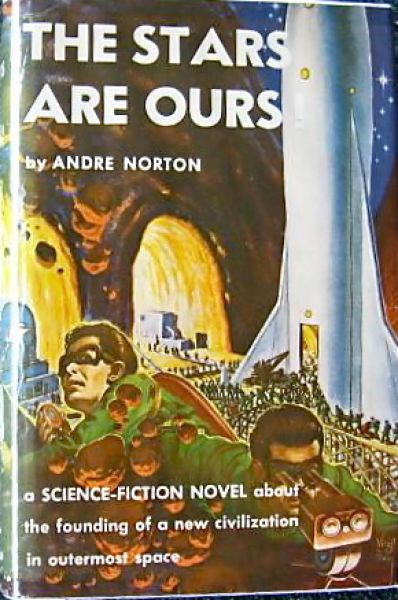Ad astra per aspera
The Stars Are Ours! (Pax, volume 1)
By Andre Norton

19 Dec, 2014
0 comments
1954’s The Stars Are Ours is, sadly, one of Norton’s minor efforts. Because I read this for the SFBC a decade ago I knew that going in but while this novel is something I am reading for completion’s sake, it does have its interesting elements1
In the world of this novel, science remained in thrall to nationalism, proceeding from fission bombs all the way to null bombs and, of course, their use. Following the death of the majority of humanity and the establishment of Pax, a fanatically anti-science autocracy, the Earth sank towards a long dark age. Only a handful of Scientists remained and they lived their lives as hunted prey.
Dard Nordis and his young niece Dessie know little of Science. Crippled older brother Lars is a different story. He is the sort of researcher who could come up with ground-breaking new technology despite the notable limitations of living as a dirt-farmer in the ruined farmhouse to which the trio fled after an anti-science purge. Lars laboured for years on one particular task; as the book opens, he has finally succeeded.
Although they have lived in the tumble-down farmhouse for years, locals still see the Nordises as strangers. This is a dystopia where strangers are enemies. Coveting the land the Nordises live on, malevolent farmer Folley calls in the dreaded Peacemen. Dard and Dessie manage to survive the carnage but both Lars and Folley (and a number of unnamed Peacemen) die in the struggle.
With the help of Folley’s stepdaughter Lotta, who loathes Folley for various good and sufficient reasons, Dard and Dessie flee the region, hoping to find refuge with the Cleft Dwellers, the last remaining community of Scientists. They take with them their ticket into that august society, the final product of Lars’ research.
Joining the Cleft Dwellers provides only a momentary respite from the Peacemen. Pax has pacified most of the Earth and now can focus their full attention on finding and killing the last of the Scientists. Rather than wait for inevitable death, the Cleft Dwellers instead opt for a bold plan, one that Lars’ work has made possible: a three-hundred-year voyage through space on the starship Ad Astra to an alien world where humans may live free once more!
There is one major problem: this is a world without ubiquitous computing devices. The only machine that can crunch the necessary space navigation numbers is the Voice, a powerful mechanical brain hidden within a secure Pax facility. Pax certainly won’t give Scientists access to the Voice. Not knowingly, at least. Cue Mission Impossible theme song.
Even if the Cliff Dwellers’ covert infiltration mission is successful, not everyone can fit into the small starship, not even if most of them are hibernating. The handful who do escape the Earth face centuries of danger in space, trusting their lives to a cold sleep technology that is new and untried. At the end of the voyage they will face a strange and alien world, a world whose dangers are entirely unknown.
Spoiler alert:
They reach their destination!
Dard and his companions soon discover their new home has its own long history, one whose abundant, half-melted ruins hint at an atomic cataclysm as terrible as the Earth’s. A cataclysm whose dreadful architects may not be entirely extinct.…
Although the plot really doesn’t stand up to close examination, and the book begins with great huge infodump, there are some nice Nortonesque flourishes in this book. The first is Lotta Folley, whom Dard dismisses as clearly inferior. The Scientists, even Scientists like Dard who are only counted as such thanks to their ancestry, seem to mirror the prejudices of the rabble. In this case, Dard’s contempt is misplaced. If not for Lotta’s quick thinking and willingness to risk herself for the survivors of the raid, all three Nordises might have died, not just Lars.
Lotta is also notable because she’s a woman in an early Norton who actually gets to have her own little agenda. She’s not on stage for long but she gets a lot accomplished in that short appearance.
The Ad Astra seems to have had pretty bad luck: it fled from a world that had suffered a self-inflicted apocalypse to a different world that had also suffered a self-inflicted apocalypse. The nature of the standard Norton universe makes this more likely than it might otherwise appear. While advanced civilizations are not uncommon in Norton’s books, these advanced cultures are usually short-lived; advanced technology brings with it the ability to burn the life from worlds but does not seem to inspire any corresponding self-control. Galactic history has a lot of churn, as cultures rise and fall and vanish entirely.
There is a sequel to this work, Star Born. I will be getting to it in six weeks2. Both The Stars Are Ours! and Star Born are available in omnibus form from Baen Books in a variety of formats.
1: Not least of which is the dedication to a young Harlan Ellison, who might not have sold his first story when Norton wrote the dedication. How odd to think someone like Norton thought kindly of him.
2: I decided to read the Nortons in strict publication order because I don’t care for all of her series and this way I don’t have to look forward to weeks or months set in one of her worlds that I happen to dislike.
